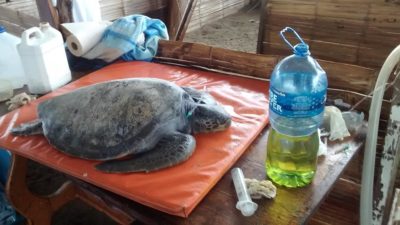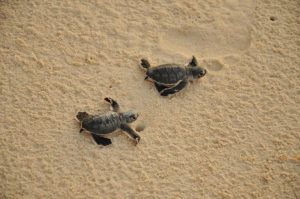By Silvia Sanchez Bor, July 16, 2016
 We’re excited to announce that WildAid has now partnered with the Machalilla wildlife hospital in Ecuador to provide comprehensive protection for sea turtles.
We’re excited to announce that WildAid has now partnered with the Machalilla wildlife hospital in Ecuador to provide comprehensive protection for sea turtles.
The seven species of sea turtle found today have been around for 110 million years. Unfortunately, six of those species are listed on the International Union for Conservation of Nature’s Red List as endangered or critically endangered, primarily due to longline fisheries, harvesting of turtle meat and eggs, predation and habitat degradation, among others.

nesting sites determines the gender of the hatchlings?
Cooler temperatures are mostly males and warmer
temperatures are mostly females. (Laura Wais)
After spending many years at sea (females from different species reach maturity at different ages, with some as old as 20-50 years of age), sea turtles return to the same spots to nest– migrating as far as 1400 miles between their feeding and nesting grounds.
Ecuador’s beaches provide an ideal nesting spot for four sea turtle species (Green Turtles, Leatherbacks, Olive-Ridley and critically endangered Hawksbill sea turtles). Over the past year, we’ve partnered with park rangers along Ecuador’s coast on various sea turtle conservation projects that include underwriting at-sea patrols, removing abandoned drift nets, marking and protecting nests from predators, releasing more than 15,000 sea turtle hatchlings into the sea, and educating the local community about the importance of sea turtles.
Sea turtles, which can live up to 80 years, are an important part of a healthy marine ecosystem and can generate more than one million dollars in annual tourism revenue. This year, WildAid is expanding sea turtle conservation efforts by working with a grassroots wildlife rehabilitation hospital at Machalilla National Park that has treated nearly 150 sea turtles, 10 sea lions and 300 sea birds over the last four years.
Sea turtles treated in the wildlife rehabilitation hospital suffer from various injuries including lesions and internal damage by fishing hooks or from getting trapped in or consuming marine debris/plastics. The wildlife hospital volunteers treat injured marine wildlife from the entire country’s coast.
It is the only facility of its kind in Ecuador and was previously funded from t-shirt sales and donations from the community. With improved infrastructure and equipment provided by WildAid, the hospital will expand operations to provide more marine wildlife with a second chance at life. Currently, there are 17 resident turtles undergoing treatment and with our support, veterinarians will be able to treat up to 27 turtles over the next year.
Work with sea turtle populations provides an opportunity to inform our future work in Machalilla, as well as that of other regions. Data collected may include trends in wildlife injuries, infectious diseases, migration patterns, systemic medical issues, and human-animal interactions, among others. This data can help inform and educate tourism and fishing policy, and provide best practices for managing Ecuador’s MPAs and fisheries to conserve the country’s marine biodiversity.